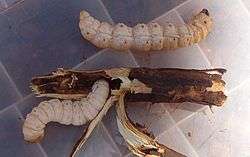Witchetty grub
The witchetty grub (also spelled witchety grub or witjuti grub[1]) is a term used in Australia for the large, white, wood-eating larvae of several moths. In particular it applies to the larvae of the cossid moth Endoxyla leucomochla, which feeds on the roots of the witchetty bush (after which the grubs are named) that is widespread throughout Northern Territory and found in parts of Western Australia and South Australia.[2]
The term may also apply to larvae of other cossid moths, ghost moths (Hepialidae), and longhorn beetles (Cerambycidae). The term is used mainly when the larvae are being considered as food. The grub is the most important insect food of the desert and has historically been a staple in the diets of Aboriginal Australians.[3]

Terminology
The Arabana term for the grub is mako witjuti (with emphasis on initial syllables); mako means grub, and witjuti refers to the shrub, not the grub itself.[4] Similarly, Ngalea peoples referred to the grub as "mako wardaruka", meaning grubs of the wardaruka (Acacia ligulata) shrub. The Pitjantjatjara name is "maku".[5]
It has been suggested that the word "witchetty" comes from Adynyamathanha wityu, "hooked stick", and vartu, "grub". Traditionally, it is rare for people to dig for them.[3]
Description
The different larvae are said to taste similar, probably because they have similar wood-eating habits. Edible either raw or lightly cooked in hot ashes, they are sought as a high-protein food by Aboriginal Australians. The raw witchetty grub tastes similar to almonds, and when cooked, the skin becomes crisp like roast chicken, while the inside becomes light yellow, like a fried egg.[3]
These grubs live in trees. They can also be found in black wattle trees, and are attributed as the reason why wattles die within 10 to 15 years. The roots of the Acacia kempeana shrub are another source of the grubs.
When held, as a defence mechanism, the grubs will secrete a brown liquid.[3]
Cultural significance
Witchetty grubs feature as Dreamings in many Aboriginal paintings.[3]
See also
References
- "CSIRO - Witjuti grub".
- Marshall Cavendish Corporation (2003). Insects and Spiders of the World. Marshall Cavendish. p. 625. ISBN 978-0-7614-7344-2.
- Isaacs, Jennifer (2002). Bush Food: Aboriginal Food and Herbal Medicine. Frenchs Forest, New South Wales: New Holland Publishers (Australia). pp. 190–192. ISBN 978-1-86436-816-1.
- Tindale, Norman (1952). "On some Australian Cossidae including the moth of the witjuti (witchety) grub". Transactions of the Royal Society of South Australia. 76: 56.
- "Mimili". Pitjantjatjara Yankunytjatjara Media. Retrieved 15 March 2020.
External links
| Wikimedia Commons has media related to Witchetty grub. |

- Witchetty Grub on Australian Insects